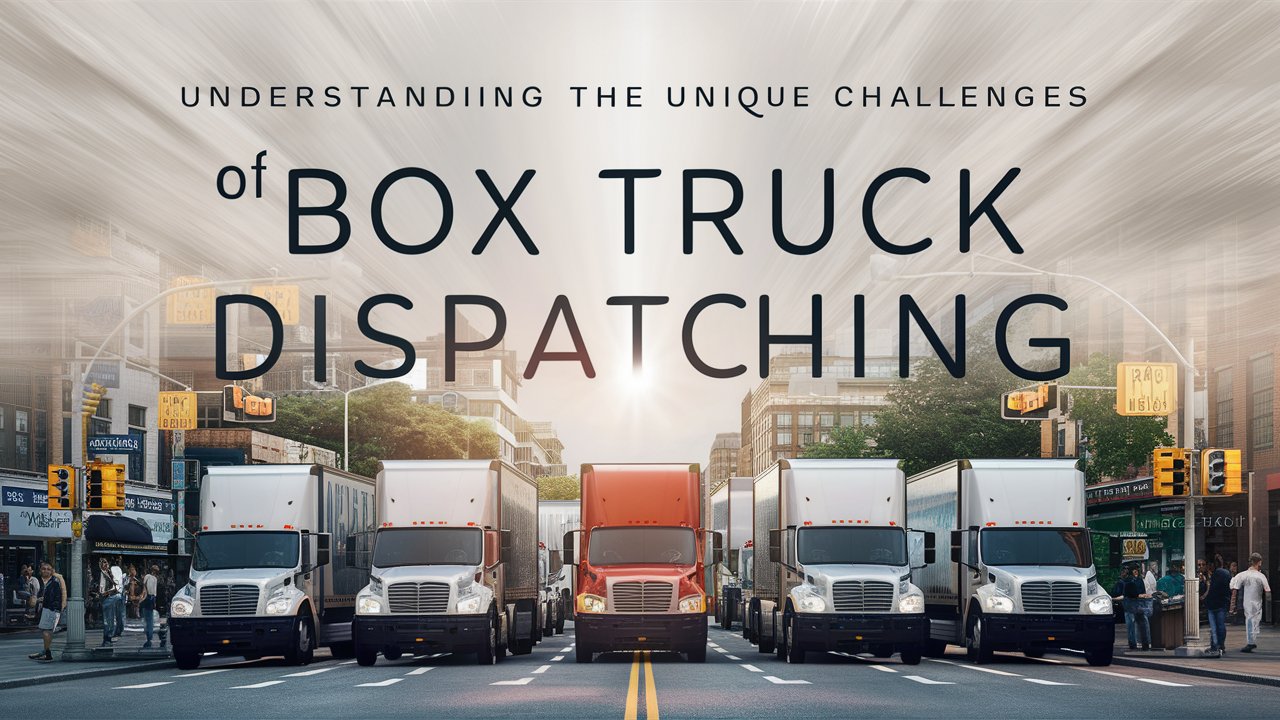Have you ever thought about how your online shopping shows up at your door right on time, even during busy holiday seasons?
The secret is something called box truck dispatching. It’s like a hidden world where quick thinking can make or break delivery schedules. In this world, new tech and human smarts work together, and surprise challenges pop up every day.
Think about being the leader of a big music group, but instead of musicians, you’re in charge of many box trucks driving all over cities and highways. That’s what a box truck dispatcher does – they keep things moving so our world runs smoothly.
What is Box Truck Dispatching?
Box truck dispatching is the art and science of coordinating the movement of box trucks to transport goods efficiently. A dispatcher serves as the maestro of this logistical symphony, managing schedules, assigning loads, and ensuring smooth operations. They are the vital link between drivers, customers, and other stakeholders in the supply chain.
Key Responsibilities of a Truck Dispatcher:
- Scheduling pickups and deliveries: Creating efficient timetables that maximize productivity.
- Assigning loads to drivers: Matching the right driver to the right load based on various factors.
- Optimizing routes: Finding the most efficient paths to reduce time and fuel costs.
- Communicating with drivers and clients: Keeping all parties informed and addressing concerns promptly.
- Handling paperwork: Managing bills of lading, proof of delivery, and other essential documents.
- Troubleshooting issues: Quickly resolving problems that arise during transport.
- Ensuring regulatory compliance: Keeping operations within legal boundaries.
- Monitoring driver performance: Tracking metrics to maintain high standards of service.
Read More Articles: The Role of Flatbed Truck Freight in the Construction and Heavy Machinery Industries
The Importance of Effective Dispatching
Effective box truck dispatch creates a well-oiled machine that benefits everyone involved. Here’s a detailed look at why it matters:
- Timely Deliveries: In today’s fast-paced world, customers expect their goods on time, every time. Good dispatching makes this consistency possible, leading to increased customer satisfaction and loyalty.
- Cost Efficiency: Optimized routes and maximized truck capacity significantly reduce operational costs. This includes savings on fuel, maintenance, and labor hours.
- Driver Satisfaction: Well-planned schedules lead to happier, more productive drivers. This results in lower turnover rates and a more experienced workforce.
- Customer Service: Smooth operations result in satisfied customers and repeat business. Effective dispatching allows for better communication and problem-solving when issues arise.
- Profitability: When all elements work together efficiently, the business becomes more profitable. This allows for reinvestment in better equipment, technology, and personnel.
Challenges in Box Truck Dispatching
-
Route Optimization
Finding efficient routes while juggling multiple factors is a constant challenge. Dispatchers must consider:
- Traffic patterns: Understanding rush hours and construction zones.
- Road conditions: Accounting for potential delays due to poor road quality.
- Weather forecasts: Planning for weather-related slowdowns or hazards.
- Delivery time windows: Meeting specific customer requirements for pickup and delivery times.
- Fuel efficiency: Balancing the shortest route with the most fuel-efficient one.
- Driver hours of service: Ensuring compliance with legal driving time limits.
- Truck capacity: Maximizing load efficiency without overloading.
Solution: Invest in advanced routing software. These AI-powered tools process variables in real time, creating optimal routes more efficiently than manual planning. They can also adapt to changes on the fly, recalculating routes as conditions change.
-
Last-Minute Changes
Adapting to unexpected changes without disrupting the entire schedule is crucial. Common changes include:
- Cancelled orders: Requiring quick rerouting and load reassignment.
- New urgent deliveries: Necessitating schedule adjustments to accommodate priority shipments.
- Traffic incidents: Causing unexpected delays and route changes.
- Vehicle breakdowns: Requiring rapid response and load transfer.
- Driver emergencies: Needing immediate schedule and assignment adjustments.
Solution: Develop a flexible dispatch system. Keep a list of backup drivers ready to step in at short notice. Create detailed contingency plans for common scenarios. Use dispatch software with real-time updating capabilities to quickly communicate changes to all relevant parties.
-
Balancing Customer Demands and Driver Needs
Meeting customer expectations while ensuring driver satisfaction is a delicate balance. This challenge requires understanding and managing the often conflicting needs of these two essential groups.
Table: Balancing Act in Box Truck Dispatching
| Customer Demands | Driver Needs |
| Quick deliveries | Reasonable working hours |
| Flexible pickup times | Adequate rest periods |
| Real-time tracking | Fair compensation |
| Special handling requests | Safe working conditions |
| Last-minute changes | Predictable schedules |
| Competitive Pricing | Professional development |
Solution: Establish realistic expectations with customers about delivery times and potential delays. Create a supportive environment for drivers through regular training, competitive pay, recognition programs, and a focus on work-life balance. Implement a robust communication system to keep both customers and drivers informed and engaged.
-
Technology Integration
Implementing and effectively using various technological tools can be challenging. Essential technologies for modern box truck dispatch include:
- Dispatch software: For scheduling and managing operations.
- GPS tracking systems: To monitor vehicle locations in real time.
- Electronic logging devices (ELDs): For tracking driver hours and ensuring compliance.
- Load boards: To find and book available freight.
- Mobile communication apps: For instant communication with drivers.
- Accounting software: To manage finances and payroll.
- Customer relationship management (CRM) tools: For maintaining customer information and history.
Solution: Invest in comprehensive technology training for all team members. Appoint a tech-savvy team member as the go-to person for troubleshooting and updates. Prioritize systems that integrate well with each other to reduce manual data entry and the potential for errors. Regular refresher courses can help ensure everyone is making the most of the available tools.
-
Compliance with Regulations
Staying up-to-date with industry regulations is crucial. Key areas of regulatory concern include:
- Hours of Service (HOS) rules: Limiting driving time to prevent fatigue.
- Weight limits and load restrictions: Ensuring safety and road preservation.
- Safety regulations: Including vehicle maintenance and driver qualifications.
- Licensing and insurance requirements: Maintaining proper documentation.
- Environmental regulations: Meeting emissions standards and other eco-friendly practices.
Solution: Consider partnering with a professional box truck dispatch service specializing in regulatory compliance. These services stay updated on changing regulations and can help ensure your operations remain compliant. Implement a system for regular compliance checks and audits to catch potential issues early. Provide ongoing training to drivers and staff about regulatory requirements and updates.
-
Managing Driver Performance and Satisfaction
Maintaining a high-performing, satisfied driver workforce is essential for any box truck dispatch operation. Key performance metrics to track include:
- On-time delivery rate: Measuring punctuality and reliability.
- Customer feedback: Gauging service quality and professionalism.
- Fuel efficiency: Assessing economical driving practices.
- Safety record: Tracking accidents, violations, and safe driving habits.
- Regulatory compliance: Ensuring adherence to all relevant laws and regulations.
Solution: Implement a comprehensive driver management program. Include regular performance reviews that not only evaluate but also provide constructive feedback. Develop a fair and transparent reward system that recognizes and incentivizes good performance. Offer ongoing training and development opportunities to help drivers improve their skills and advance their careers. Maintain an open-door policy for addressing concerns and gathering feedback. Implement health and wellness initiatives to support driver wellbeing.
-
Handling Documentation and Paperwork
Managing paperwork efficiently and accurately is vital in box truck dispatching. Common documents that need careful handling include:
- Bill of Lading: Detailing the type, quantity, and destination of goods.
- Proof of Delivery: Confirming successful delivery to the recipient.
- Driver Logs: Recording driving hours and rest periods.
- Inspection Reports: Documenting vehicle condition and maintenance.
- Fuel Receipts: Tracking fuel expenses for accounting and tax purposes.
- Accident Reports: Detailing any incidents or accidents (when necessary).
Solution: Transition to digital documentation wherever possible. Many box truck dispatch services now offer paperless solutions that can streamline this process. Digital documents are easier to store, retrieve, and share, reducing the chances of lost or damaged paperwork. Implement a double-check system for crucial documents to catch errors early. This can save time and prevent issues down the line. Train all staff on proper documentation procedures to ensure consistency and accuracy.
Read More Articles: Key Factors Influencing Pricing in Flatbed Truck Freight Services
Advanced Strategies for Effective Box Truck Dispatching
- Predictive Analytics: Utilize the power of big data to anticipate busy periods, potential delays, and maintenance needs. This allows for proactive planning and resource allocation.
- Dynamic Pricing: Implement a flexible pricing model that adjusts based on factors like demand, distance, and time of day. This can help maximize profitability during peak periods and attract more business during slower times.
- Customer Self-Service Portals: Provide user-friendly platforms where customers can book services, track deliveries, and access important documents. This reduces the workload on your dispatch team and improves customer satisfaction through increased transparency.
- Driver Gamification: Introduce elements of gamification into your driver management system. Create leaderboards for performance metrics, award badges for achievements, and offer rewards for meeting specific goals. This can boost motivation and engagement among drivers.
- Sustainability Initiatives: Implement eco-friendly practices in your box truck dispatch operations. This could include optimizing routes for fuel efficiency, investing in electric or hybrid vehicles, and using biodegradable packaging materials. Not only does this reduce your environmental impact, but it can also appeal to environmentally conscious customers.
Wrap Up
Whether you handle dispatching in-house or use a specialized box truck dispatch service, focus on continuous improvement and adaptation. Stay informed about industry trends, and prioritize clear communication with your team and customers.
Want to turn your downtime into drive time? Tech Rig Dispatch is here to rev up your profits. Don’t let your rig sit idle while bills pile up. Join our network today and get into a world of steady loads and reliable income.



